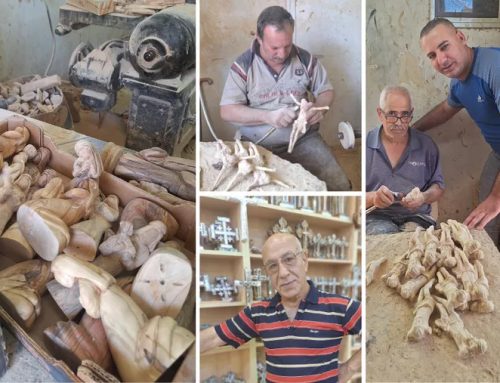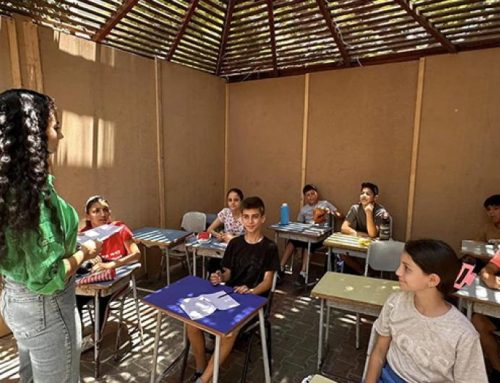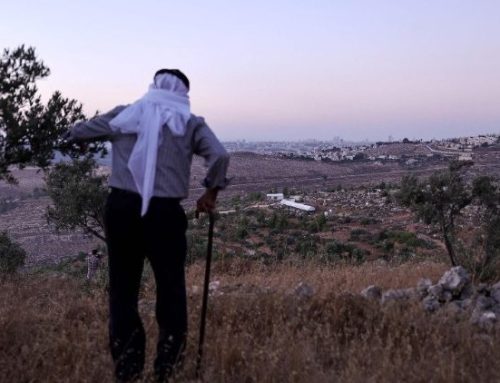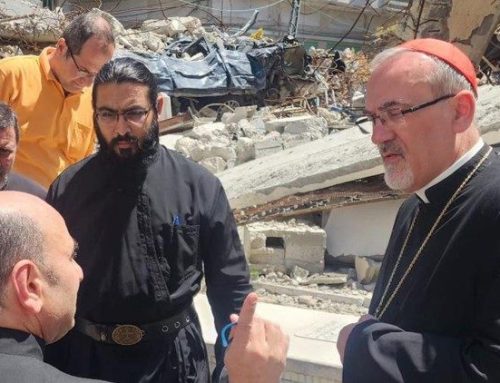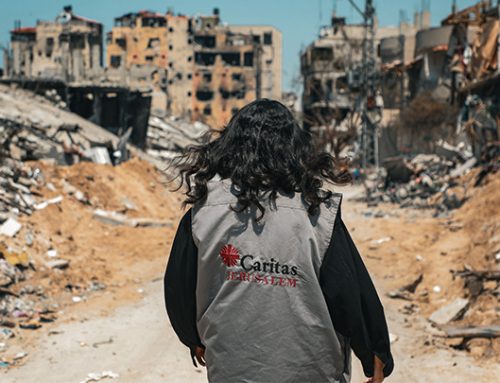A decade ago, I spent Easter in Damascus. Big chocolate bunnies and a baskets of pastel eggs decorated shop windows in the Old City. Both the Catholic and Orthodox Easters were celebrated, and all Syrians were given time off for both three-day holidays on sequential weekends. I stopped in the Umayyad Mosque, which was built in the eighth century and named after the first dynasty to lead the Islamic world. The head of John the Baptist is reputedly buried in a large domed sanctuary—although claims vary—on the mosque’s grounds. Muslims revere John as the Prophet Yahya, the name in Arabic. Because of his birth to a long-barren mother and an aged father, Muslim women who are having trouble getting pregnant come to pray at his tomb. I watched as Christian tourists visiting the shrine mingled with Muslim women.
At least half of Syria’s Christians have fled since then. The flight is so pronounced that, in 2013, Gregory III, the Melkite Patriarch of Antioch, Alexandria, and Jerusalem, wrote an open letter to his flock: “Despite all your suffering, stay here! Don’t emigrate!”
“We exhort our faithful and call them to patience in these tribulations, especially in this tsunami of stifling, destructive, bloody and tragic crises of our Arab world, particularly in Syria, but also to different degrees in Egypt, Iraq, Palestine and Lebanon,” he wrote. “Jesus tells us, ‘Fear not!’ ”
Syria’s Christians are part of a mass exodus taking place throughout the Middle East, the cradle of the faith. Today, Christians are only about four per cent of the region’s more than four hundred million people—and probably less. They “have been subject to vicious murders at the hands of terrorist groups, forced out of their ancestral lands by civil wars, suffered societal intolerance fomented by Islamist groups, and subjected to institutional discrimination found in the legal codes and official practices of many Middle Eastern countries,” as several fellows at the Center for American Progress put it.
Last weekend, suicide bombings in two Egyptian Coptic churches in Alexandria and Tanta, sixty miles north of Cairo, killed almost four dozen Egyptians and injured another hundred. The Palm Sunday attacks, coming just weeks before Pope Francis is due to visit the country, led the Coptic Church to curtail Easter celebrations in a country that has the largest Christian population—some nine million people—in the Middle East. A pillar of the early faith, the Copts trace their origins to the voyage of the Apostle Mark to Alexandria.
“We can consider ourselves in a wave of persecution,” Bishop Anba Macarius, of the Minya diocese, who survived an assassination attempt in 2013, said on Thursday.
The isis affiliate in the Sinai Peninsula claimed credit for the attacks. In the past two years, it has carried out a series of gruesome killings of Christians, including the forced march of twenty-one Egyptian workers in Libya, all Coptic Christians, each clad in an orange prison jumpsuit, to a Mediterranean beach, where they were forced to kneel and then beheaded. isis threats against Christians have escalated since a suicide bombing on December 11th at St. Mark’s Cathedral, in Cairo, killed more than two dozen Egyptians. After a February attack that killed seven Christians on Egypt’s Sinai Peninsula, the majority of Copts have fled the Sinai, according to Human Rights Watch.
The largest exodus of Christians is in Iraq, where the group has been trapped in escalating sectarian clashes between Sunni and Shiite Muslims, targeted by an Al Qaeda franchise, and forced to flee by the Islamic State. “There were 1.3 million Christians in Iraq in 2003. We’re down by a million since then,” with hundreds more leaving each month, Bashar Warda, a Chaldean bishop in the northern city of Erbil, the Kurdish capital, told me last month. He was wearing a pink zucchetto skullcap and an amaranth sash tied around his black cassock. A large silver cross hung around his neck.
“It’s very hard to maintain a Christian presence now,” Warda said. “Families have ten reasons to leave and not one reason to stay. This is a critical time in our history in this land. We are desperate.”
Last month, I drove to Mosul, Iraq’s second-largest city and home for two millennia to one of the world’s oldest Christian communities. Within days of its conquest of Mosul, isis issued an ultimatum to Christians to either convert to Islam, pay an exorbitant and open-ended tax, or face death “by the sword.” Homes of Christians were marked by a large “N” for “Nassarah,” a term in the Koran for Christians.
Some thirty-five thousand Christians fled. Many of their homes were ransacked and then set alight. En route to Mosul, I passed other Christian villages, like Bartella, that had also emptied. Even gravestones at the local cemetery were bullet-ridden. In all, a hundred thousand Christians from across the Biblical Nineveh Plains are estimated to have abandoned their farmlands, villages, and towns for refuge in northern Kurdistan—or beyond Iraq’s borders.
“For the first time in the history of Iraq, Mosul is now empty of Christians,” the Chaldean Patriarch Louis Sako told Agence France-Presse.
The Christian flight has broader implications for the Middle East. “If one of the most important religious groups in the world continues to be forced out of the Middle East, this bodes negatively for pluralism, tolerance, and the ability of the region’s people to live interlinked with the rest of the world,” the Center for American Progress reported. The status of Christians “is a barometer of whether those of other faiths or no faith at all will be able to live and thrive in the future Middle East.”
In Erbil, fifteen hundred Christian families displaced by isis now live in shipping containers converted into temporary homes in Ashti-2, a teeming camp with narrow dirt roads. Outside the camp, I met Salam Ablaha, a thirty-six-year-old grocer. An Assyrian Christian, he fled Hamdaniya, near Mosul, in August, 2014. He now runs an open-air stall that sells green apples, tomatoes, mushrooms, lemons, and carrots stacked high on crates. He had a light beard and was wearing a black fleece jacket to ward off the spring chill. His extended family of twenty-six—his wife, three children, parents, and the families of seven brothers—live off the charity from the Iraqi Assyrian Church and his modest earnings.
Like many Christians I interviewed, Ablaha has no intention of returning to Hamdaniya. Since the city was liberated, last October, he’s been back once to check on his home. The furniture was gone; so were the windows and doors.
“None of us want to go back,” he told me. “We’re still scared of what will happen after isis.” There’s a widespread fear among Christians about the emergence of a third iteration of Islamic extremism—after the rise of an Al Qaeda affiliate, a decade ago, and isis, during the past three years. Ablaha’s brother was kidnapped by Al Qaeda in 2007; he was freed only after the family paid a hefty ransom.
“Before 2003, we had a perfect life. I never thought about leaving,” Ablaha told me. “But we’re a minority. We don’t have support or someone to protect us. Christians are now waiting to go to Jordan and from there to Australia. Seventy per cent of the people from Hamdaniya have already left Iraq.”
I asked if he thought Christians had a future in the Middle East. “No! No!” he said. “By 2020, most Christians will have left Iraq.”
Bishop Warda was only slightly more optimistic. “We have to stay,” he told me. “But how many will stay? I doubt fifty, a hundred, or a thousand families will stay in the end.” After two thousand years, the Christian presence would have to adapt to a different role, he said. “We will have to become missionaries.”
By: Robin Wright
Source: The New Yorker


